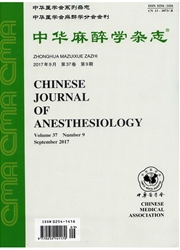

 中文摘要:
中文摘要:
目的评价不同剂量右美托咪定对丙泊酚复合瑞芬太尼用于整形外科手术患者麻醉效果的影响。方法择期行大面积皮肤瘢痕切除和进行皮瓣转移的手术患者60例,性别不限,年龄18。64岁,体重45~75kg,ASA分级I或Ⅱ级,采用随机数字表法,将患者.分为3组(n=20):对照组(C组)、低剂量负荷量右美托咪定组(D1组)和高剂量负荷量右美托咪定组(D2组),D。组和D:组分别于麻醉诱导前10min静脉输注右美托咪定0.6、1.0μg/kg负荷量,随后以0.4μg·kg^-1·h^-1速率静脉输注至手术结束前30min。麻醉诱导:靶控输注丙泊酚(血浆靶浓度4.0μg/ml)和瑞芬太尼(效应室靶浓度2.0ng/m1),患者意识消失后静脉注射罗库溴铵0.6mg/kg,气管插管后,机械通气,麻醉维持:靶控输注丙泊酚(血浆靶浓度2.0~3.5μg/ml)和瑞芬太尼(效应室靶浓度1.5—2.5ng/m1),维持Narco.trend指数为D级。分别于麻醉前、右美托咪定输注10min、气管插管前即刻、气管插管后1min、气管插管后5min、停止输注右美托咪定、拔除气管导管前即刻、拔除气管导管后1min、拔除气管导管后5min时记录Narcotrend指数、收缩压(SP)、舒张压(DP)和HR。记录麻醉诱导时间、丙泊酚和瑞芬太尼的用量,记录自主呼吸、定向力恢复和拔除气管导管的时间。拔除气管导管后10rain时行镇静一躁动评分,记录术中窦性心动过缓和麻醉恢复期不良事件的发生情况。结果与C组比较,D1组和D2组丙泊酚、瑞芬太尼的总用量和拔除气管导管后10min时镇静一躁动评分、麻醉恢复期恶心、呛咳和躁动的发生率降低,右美托咪定输注10min时Narcotrend指数和HR降低,D2组麻醉诱导时间缩短(P〈0.05或0.01),D2组术中窦性心动过缓发生率高于C组和D1组(P〈0.05),3组间自主呼吸恢复时间、定向力恢复时间和?
 英文摘要:
英文摘要:
Objective To investigate the effects of different doses of dcxmedetomidine on the anesthetic efficacy of propofol and remifentani] in patients undergoing plastic surgery. Methods Sixty ASA Ⅰ or Ⅱ patients of both sexes, aged 18-64 yr, weighing 45-75 kg, scheduled for elective plastic surgery, were randomly assigned into 3 groups ( n = 20 each) : control group (C group), low loading dose dexmedetomidine group (D1 group) and high loading dose dexmedetomidine group (D2 group ). Dexmedetomidine was infused at a rate of 0.4 μg· kg- 1 . h- 1 until 30 min before the end of surgery after a loading dose of dcxmedetomidine 0.6 ( group D1 ) or 1.0 μg/kg (group I:)2 ) was infused at 10 min before induction of anesthesia in groups D1 and D2 . Anesthesia was induced with target-controlled infusion of propofol (target plasma concentraiton 4.0 μg/ml) and remifentanil (target effect-site concentraiton 2.0 ng/ml). After the patients lost consciousness, rocuronium 0.6 mg/kg was injected in- travenously. The patients were mechanically ventilated after tracheal intubation. Anesthesia was maintained with target-controlled infusion of propofol (target plasma concentralton 2.0-3.5 μg/ml) and remifentanil (target effect- site concentraiton 1.5-2.5 ng/ml). Narcotrend index was maintained at Class D. Narcotrend index, systolic pres- sure (SP), diastolic pressure (DP) and HR were recorded before anesthesia (baseline), at 10 min of dexmedeto- midine infusion, at 0, 1 and 5 min after tracheal intubation, at the end of dexmedetomidine infusion, and at 0, 1 and 5 min after removal of the endotrachcal tube. The induction time, consumption of propofol and remifentanil, time for recovery of spontaneous breathing and orientation, extubation time, and Richmond Agitation Sedation Scale score at 10 min after removal of the endotracheal tube were recorded. The development of sinus bradycardia during operation and complications during recovery from anesthesia were also recorded. Results
 同期刊论文项目
同期刊论文项目
 同项目期刊论文
同项目期刊论文
 Neuroprotective effects of isoflurane preconditioning in a murine transient global cerebral ischemia
Neuroprotective effects of isoflurane preconditioning in a murine transient global cerebral ischemia Upregulation of EMMPRIN (OX47) in Rat Dorsal Root Ganglion Contributes to the Development ofMechanic
Upregulation of EMMPRIN (OX47) in Rat Dorsal Root Ganglion Contributes to the Development ofMechanic Hyperbaric oxygen therapy attenuates neuropathic hyperalgesia in rats and idiopathic trigeminal neur
Hyperbaric oxygen therapy attenuates neuropathic hyperalgesia in rats and idiopathic trigeminal neur 期刊信息
期刊信息
